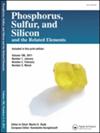DFT-based computational insights and biological evaluation of N,N-dimethylamino pyridinium halide Lewis Base adducts
IF 1.4
4区 化学
Q4 CHEMISTRY, INORGANIC & NUCLEAR
Phosphorus, Sulfur, and Silicon and the Related Elements
Pub Date : 2025-05-04
DOI:10.1080/10426507.2025.2499146
引用次数: 0
Abstract
This study investigates the geometric and electronic properties of N,N-dimethylamino pyridinium halide Lewis base adducts using density functional theory (DFT) and assesses their antibacterial efficacy. DFT calculations were conducted on 11 pyridinium salts, to analyze geometry, electronic structure and chemical reactivity. Key quantum chemical parameters including electron affinity (A), ionization potential (I), electron negativity (χ), HOMO-LUMO energy gap ΔE, electrophilicity index (ω), dipole moment (μ), hardness (η) and softness (S) were derived to predict potential sites for nucleophilic and electrophilic attacks. The antibacterial activity of these compounds was evaluated in vitro against four Gram negative and three Gram positive bacteria using the broth dilution method. Compounds A (4-(dimethylamino)-1-tosyl pyridinium chloride) and E (1-bromo-4-(dimethylamino) pyridinium bromide) demonstrated complete inhibition of all seven tested bacterial strains at a concentration of 20 ppm. Compound 2 (4-(dimethylamino)-1-(phenylsulfonyl) pyridinium chloride) exhibited moderate activity against Salmonella typhimurium (Gram-negative) and Bacillus subtilis (Gram-positive). Compound B (1-benzyl-4-(dimethylamino) pyridinium chloride) inhibited two Gram-negative bacteria (Shigella boydi, S.typhimurium) and two Gram-positive (Streptococcus sp., Staphylococcal sp.) bacteria. The findings provide valuable insights into the relationship between the electronic properties of N,N-dimethylamino pyridinium halide adducts and their antibacterial activity, suggesting that specific structural features contribute to enhanced antibacterial efficacy.
基于dft的N,N-二甲氨基卤化吡啶刘易斯碱加合物的计算见解和生物学评价
利用密度泛函理论(DFT)研究了N,N-二甲氨基卤化吡啶刘易斯碱加合物的几何和电子性质,并对其抗菌效果进行了评价。对11种吡啶盐进行了DFT计算,分析了它们的几何结构、电子结构和化学反应性。推导了关键的量子化学参数,包括电子亲和力(A)、电离势(I)、电子负性(χ)、HOMO-LUMO能隙ΔE、亲电性指数(ω)、偶极矩(μ)、硬度(η)和柔软度(S),以预测亲核和亲电攻击的潜在位点。采用肉汤稀释法对4种革兰氏阴性菌和3种革兰氏阳性菌进行体外抑菌活性评价。化合物A(4-(二甲胺)-1-甲酰基氯化吡啶)和E(1-溴-4-(二甲胺)溴化吡啶)在浓度为20ppm时显示出对所有7种测试菌株的完全抑制作用。化合物2(4-(二甲氨基)-1-(苯磺酰基)氯化吡啶)对鼠伤寒沙门菌(革兰氏阴性)和枯草芽孢杆菌(革兰氏阳性)具有中等活性。化合物B(1-苄基-4-(二甲氨基)氯化吡啶)抑制2种革兰氏阴性菌(博氏志贺氏菌、鼠伤寒沙门氏菌)和2种革兰氏阳性菌(链球菌、葡萄球菌)。这些发现为研究N,N-二甲氨基卤化吡啶加合物的电子性质与其抗菌活性之间的关系提供了有价值的见解,表明特定的结构特征有助于增强抗菌效果。
本文章由计算机程序翻译,如有差异,请以英文原文为准。
求助全文
约1分钟内获得全文
求助全文
来源期刊
CiteScore
2.60
自引率
7.70%
发文量
103
审稿时长
2.1 months
期刊介绍:
Phosphorus, Sulfur, and Silicon and the Related Elements is a monthly publication intended to disseminate current trends and novel methods to those working in the broad and interdisciplinary field of heteroatom chemistry.

 求助内容:
求助内容: 应助结果提醒方式:
应助结果提醒方式:


